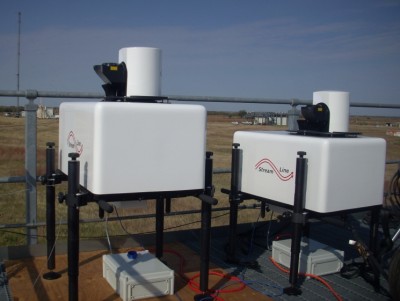Testing Underway for New Doppler Lidars
Published: 25 October 2010

To improve climate models, the scientific community needs accurate and routine measurements of atmospheric winds with high vertical and temporal resolution under clear-air conditions. In particular, measurements of clear-air vertical air velocities will compliment in-cloud vertical velocity measurements from existing 35 and 95 gigahertz ARM cloud radars. In response to this need, three new Doppler lidars were purchased with funds from the
American Recovery and Reinvestment Act and began a test period at the ARM Southern Great Plains site in October. This progress brings the ARM Facility one step closer to adding these important new measurements to its data collection.
As an active remote-sensing instrument, the Doppler lidar provides range- and time-resolved measurements of radial velocity and attenuated backscatter. It operates similar to a radar in that pulses of energy are transmitted into the atmosphere, and energy scattered back to the transceiver is collected and measured as a time-resolved signal. The instrument’s processor automatically handles the generation of the velocity and backscatter data products. This lidar also has full upper-hemispheric scanning capability, enabling 3D mapping of turbulent flows in the atmospheric boundary layer.
Following the test period at SGP, one of the lidars will remain at SGP for permanent operations, and the second will be Darwin, Australia for permanent operations there. The third will become part of the ARM Mobile Facility instrument suite; it will be sent to a staging facility in Pagosa Springs, Colorado, in preparation for the next AMF deployment to India in spring 2011. A new data ingest is under development for transferring the new datastreams to the ARM Data Archive.
The ARM Climate Research Facility is a DOE Office of Science user facility. The ARM Facility is operated by nine DOE national laboratories, including .
Keep up with the Atmospheric Observer
Updates on ARM news, events, and opportunities delivered to your inbox
ARM User Profile
ARM welcomes users from all institutions and nations. A free ARM user account is needed to access ARM data.


















